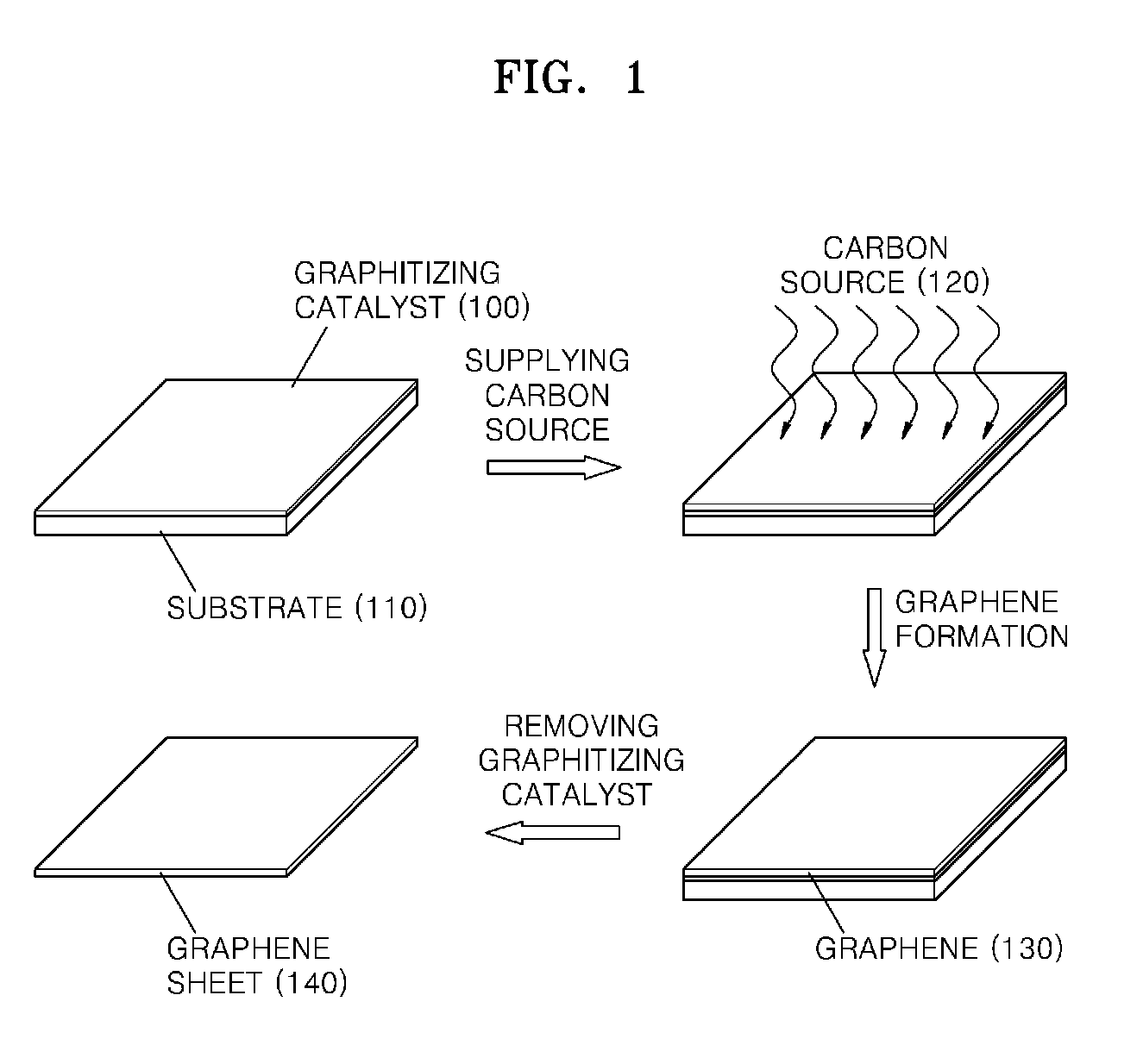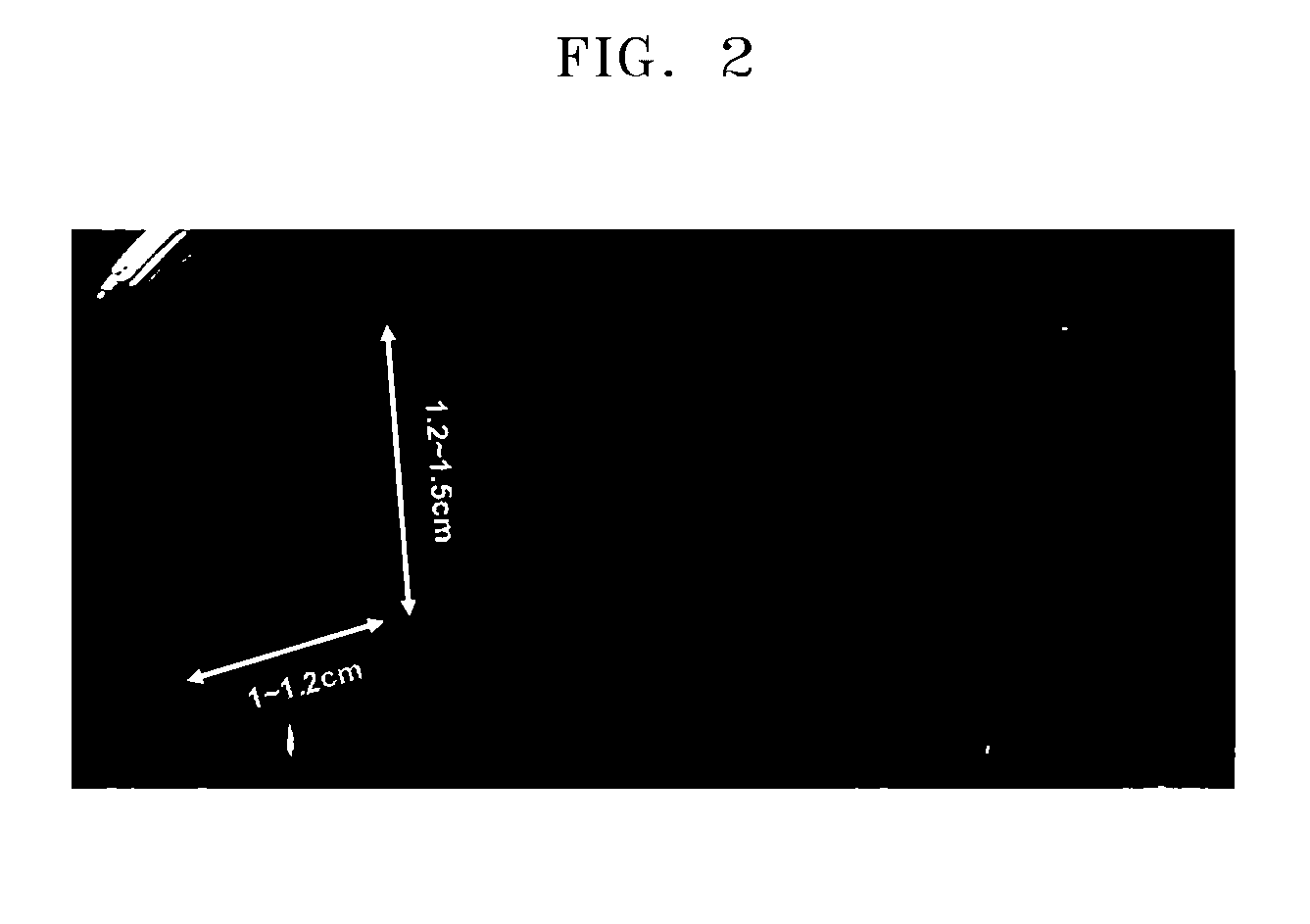Graphene sheet and method of preparing the same
a graphene sheet and graphene technology, applied in the field of graphene sheets, can solve the problems of high cost of carbon nanotubes, difficulty in separating single-walled carbon nanotubes, and the inability to economically and reproducibly prepare a large-scale graphene sh
- Summary
- Abstract
- Description
- Claims
- Application Information
AI Technical Summary
Benefits of technology
Problems solved by technology
Method used
Image
Examples
example 1
[0074]A graphitizing catalyst film was formed by depositing Ni on a 1.2 cm×1.5 cm silicon substrate on which 100 nm of SiO2 was coated by sputtering to form a Ni thin film with a thickness of 100 nm. The silicon substrate on which the SiO2 and Ni thin film were formed was disposed in a chamber, and the substrate heat-treated at 400° C. for 20 minutes using a halogen lamp as a heat source while acetylene gas was added to the chamber at a constant rate of 200 sccm to form graphene on the graphitizing catalyst.
[0075]Then, a 7 layered graphene sheet having a size of 1.2 cm×1.5 cm was formed by removing the heat source and naturally cooling the interior of the chamber to grow graphene in a uniform arrangement.
[0076]Then, the substrate including the graphene sheet was immersed in 0.1 M HCI for 24 hours to remove the Ni thin film. The graphene sheet separated from the substrate during the immersion. FIG. 2 is a photographic image of the graphene sheet prepared according to Example 1.
[0077]...
example 2
[0079]A 16 layered graphene sheet having a size of 1.2 cm×1.5 cm was prepared in the same manner as in Example 1, except that the heat-treatment was performed at 500° C. instead of 400° C.
[0080]Then, the substrate including the graphene sheet was immersed in 0.1 M HCI for 24 hours to remove the Ni thin film. The graphene sheet separated from the substrate during the immersion.
[0081]FIG. 3 is a graph illustrating a Raman spectrum of the graphene sheet. Referring to FIG. 3, the formation of graphene can be identified by the G′ peak shown at 1594 cm−1.
[0082]FIG. 5 is a SEM image of the graphene sheet formed in Example 2. Referring to FIG. 5, it can be seen that a uniform graphene sheet was formed because features are not observed in the SEM image.
example 3
[0083]A 32 layered graphene sheet having a size of 1.2 cm×1.5 cm was prepared in the same manner as in Example 1, except that the heat-treatment was performed at 600° C. instead of 400° C.
[0084]Then, the substrate including the graphene sheet was immersed in 0.1 M HCI for 24 hours to remove the Ni thin film. The graphene sheet separated during the immersion.
[0085]FIG. 3 is a graph illustrating a Raman spectrum of the graphene sheet. Referring to FIG. 3, the formation of graphene can be identified by the G′ peak shown at 1594 cm−1.
PUM
| Property | Measurement | Unit |
|---|---|---|
| Temperature | aaaaa | aaaaa |
| Temperature | aaaaa | aaaaa |
| Time | aaaaa | aaaaa |
Abstract
Description
Claims
Application Information
 Login to View More
Login to View More - R&D
- Intellectual Property
- Life Sciences
- Materials
- Tech Scout
- Unparalleled Data Quality
- Higher Quality Content
- 60% Fewer Hallucinations
Browse by: Latest US Patents, China's latest patents, Technical Efficacy Thesaurus, Application Domain, Technology Topic, Popular Technical Reports.
© 2025 PatSnap. All rights reserved.Legal|Privacy policy|Modern Slavery Act Transparency Statement|Sitemap|About US| Contact US: help@patsnap.com



